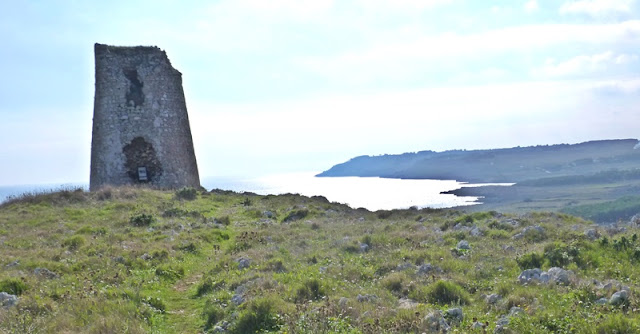Tuesday, October 27, 2015
We began the day with a
drive to Otranto, the easternmost point in Italy, and way down the heel, where
the Adriatic Sea meets the Ionian Sea, just 25 miles or so from the Albanian
coast:
The old city of Otranto is
another UNESCO World Heritage Site, featuring the Otranto castle, Castello
Aragonese, which is truly massive. It
was a wonderful protection against attacks from the water:
In the shop windows were “pupa
liccese” dolls which were explained to us as figures used by local custom for
engagements:
After touring the castle
we went to the Mosaico Otranto Cathedral, consecrated in 1088, which is famous
for the enormous mosaic floor, perhaps the largest in the world, made between
1163 and 1165 by local artisans supervised by a local priest. The main theme is a tree of life:
From Wikipedia (in
translation from Italian), “The iconography of the mosaic is spread through
scenes from Old Testament, from the cycles of chivalry, and the bestiary
medieval, from the novel by Alessandro. The images are arranged along the
development of the tree of life, trace the human experience from original sin
to salvation.” Well, things here range
from easy to understand to pretty unusual.
Here are Abraham Isaac and Jacob:
Here’s a creature with a
human head, a four-legged animal’s body, two rear legs, a human foreleg, and a
human arm:
Here’s a sort of lion head
with four bodies:
There is a beautiful early
18th c. organ:
And there’s a terrible
story. In 1480 the Turks were in control
and required conversion to Islam for all the residents. 800 of the local populace refused and were
beheaded. Their remains are sealed in
the Chapel of the Martyrs, and the bones are on view:
The 800 were beatified by
the Pope, which is interesting, as there was a significant Jewish population
here, and it’s not for sure that all the 800 who were beheaded were Christians. Thus it’s quite possible that there are some
beatified Jews’ bones in these cases.
We left Otranto and drove
to the coast, where we had another large lunch, this time at the Masseria
Panareo, following which the three men along with our guide Ido hiked up to an
abandoned lookout at the edge of the sea on a bluff. This was part of a string of watchtowers along
the coast erected by the Spanish in the 15th c.:
We drove back to Lecce in
time for a guided tour run by the local tourist office. We thought we had signed up for a tour of the
Lecce synagogue, but it no longer exists, or, rather, is now a
nightclub/restaurant and just about all traces of the synagogue are gone. We sat in the basement of the structure while
the guide told us about it. Then, we
embarked on a tour of Lecce which we did not realize we had signed up for. We walked the town and admired the Roman
amphitheater which had been discovered during some construction:
We ended at a remarkable
private museum. The story is amazing,
but not out of the ordinary here! A
local man wanted to open a restaurant, but he had some problems with the
drainpipe to his toilet. As he dug to
find the leak, he came upon an absolute treasure, multiple rooms and layers of
history dating all the way back to the Messapii in the 8th c.
BCE. His story is documented in an
article in the NYTimes from this past spring:
The really fine artifacts
were taken by the government, but there’s lots still here. In one case is a broken menorah of unknown
age:
Tomorrow, Gallipoli—the Italian
one, not the Turkish one. A Gallipoli I
never knew existed!















No comments:
Post a Comment